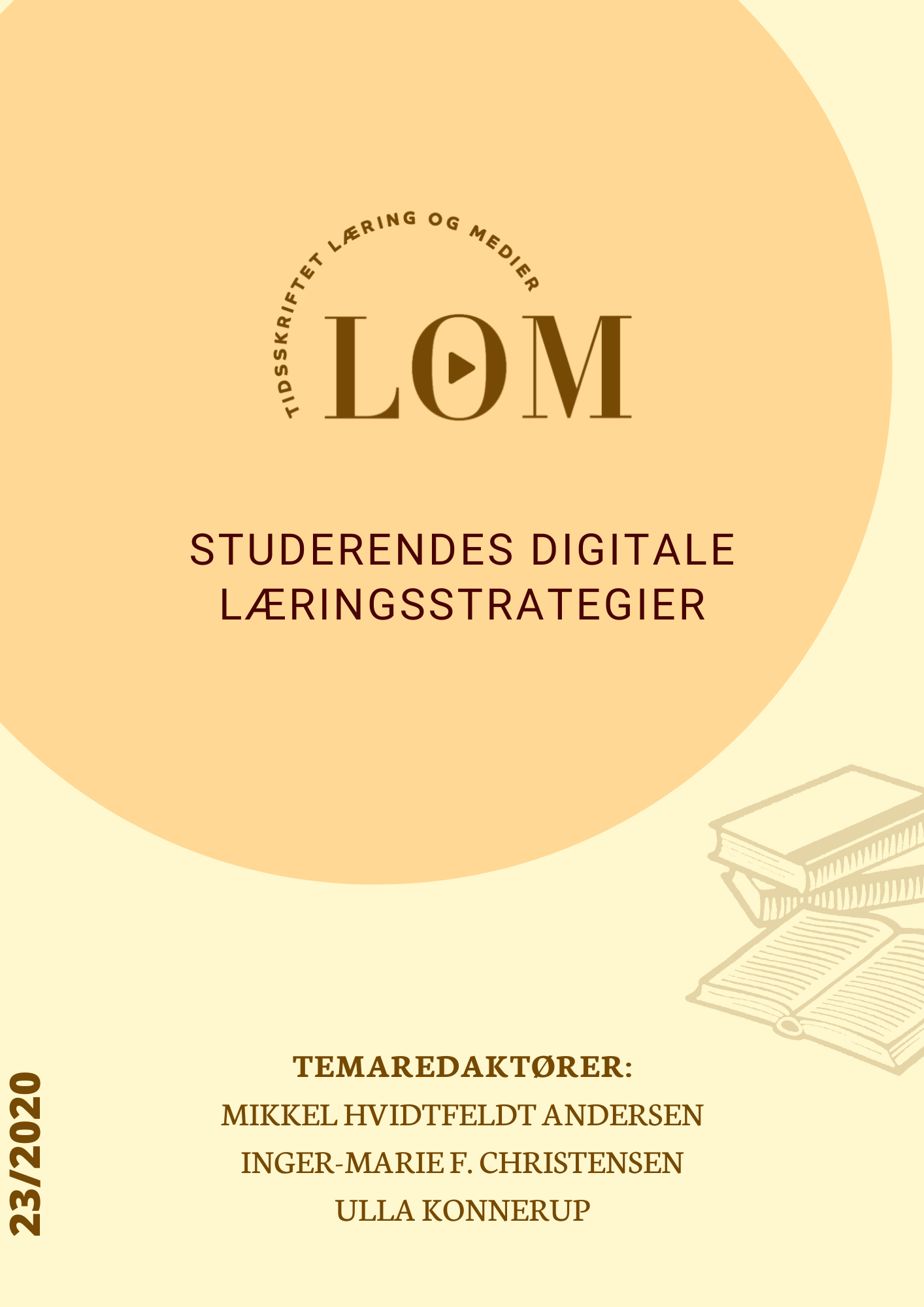Sammen, hver for sig: universitetsstuderendes læringsstrategier under COVID19-nedlukningen
DOI:
https://doi.org/10.7146/lom.v13i23.122032Keywords:
COVID-19, Learning strategies, Community of practiceAbstract
This article examines how university students handled the transition to digital teaching and learning during the COVID19 lockdown of Danish society in the spring of 2020. With a theoretical grounding in especially Wenger's conceptual apparatus (1998) about communities of practice and learning trajectories, we ask what strategies the students used to deal with the absence of the normal physical learning space. The empirical material of the study consists of qualitative interviews (all conducted during the lockdown) with 23 students from all study programmes and study years at the IT University of Copenhagen. The students used platforms like Facebook, Discord and Zoom to establish replacements for the lost physical learning spaces. However, the analysis shows that while students with existing academic or social relationships with fellow students generally succeeded in forming communities of practice, most students only had fleeting relationships across platforms or even experienced loneliness and resignation. In conclusion, we discuss relationships and overlaps between teaching communities, study communities and support communities during the COVID19 lockdown.
Downloads
References
American Psychological Association (2020). “Call for Papers: COVID-19 Pandemic”, https://www.apa.org/pubs/journals/stl/call-for-papers-covid-19-pandemic, tilgået 23. oktober 2020.
Axel, E., & Tanggaard, L. (2010). En introduktion til Situeret læring og praksis i forandring. Nordisk Udkast, (1), 3-8.
Bøttcher, T. (2020). Professor i e-læring om nyt krav på CBS: “Det er meget ambitiøst”. Magisterbladet, 13. maj 2020. https://www.magisterbladet.dk/aktuelt/2020/maj/professor-i-e-laering-om-nyt-krav-paa-cbs-det-er-meget-ambitioest, tilgået 23. oktober 2020.
Ellis, R.A., & Goodyear, P. (2016). Models of learning space: integrating research on space, place and learning in higher education. Review of Education, 4(2), 149–191.
Fenwick, T., Edwards, R. & Sawchuk, P. (2015). Emerging approaches to educational research: Tracing the socio-material. Routledge.
Flyvbjerg, B. (2006). Five Misunderstandings About Case-Study Research. Qualitative Inquiry, 12(2): 219-245.
Garrison, D. R., & Archer, W. (2000). A Transactional Perspective on Teaching and Learning: A Framework for Adult and Higher Education.
Goffman, E. (1959). The Presentation of Self in Everyday Life. London: Penguin Books.
Hacker, J., vom Brocke, J., Handali, J., Otto, M., & Schneider, J. (2020). Virtually in this together – how web-conferencing systems enabled a new virtual togetherness during the COVID-19 crisis, European Journal of Information Systems. Udgivet online 29. september 2020.
Hjarvard, S. (2005). Det selskabelige samfund. Essays om mennesker og medier, 2. udgave. Frederiksberg: Samfundslitteratur.
Hjelholt, M., & Schou, J. (2017). Den digitale borger. København: Hans Reitzels Forlag.
Hodges, C., Moore, S., Lockee, B., Trust, T., & Bond, A. (2020). The Difference Between Emergency Remote Teaching and Online Learning. Educause Review, 27. marts 2020. https://er.educause.edu/articles/2020/3/the-difference-between-emergency-remote-teaching-and-online-learning, tilgået 23. oktober 2020.
Hrastinski, S. (2009). A theory of online learning as online participation. Computers and Education, 52(1), 78–82. https://doi.org/10.1016/j.compedu.2008.06.009
Kvale, S. (1997). Interview. En introduktion til det kvalitative forskningsinterview. København: Hans Reitzels Forlag.
Lave, J. & Wenger, E. (1991). Situated learning - Legitimate peripheral participation. Cambridge: Cambridge University Press.
Lave, J. & Wenger, E. (2003). Situeret læring - og andre tekster. København: Hans Reitzels Forlag.
Læring og Medier (2020), “Call #24” https://tidsskrift.dk/lom/index
Meyrowitz, J. (1985). No Sense of Place. The Impact of Electronic Media on Social Behavior. New York: Oxford University Press.
NLEC (Networked Learning Editorial Collective). (2020). Networked Learning: Inviting Redefinition. Postdigital Science and Education.
Rapanta, C., Botturi, L., Goodyear, P., Guàrdia, L., & Koole, M. (2020). Online University Teaching During and After the Covid-19 Crisis: Refocusing Teacher Presence and Learning Activity. Postdigital Science and Education, 2(3), 923–945.
Sivan, E. (1986). Motivation in Social Cognitive Theory. Educational Psychologist.
Shapka, J.D., Domene, J. F., Khan, S. & Yang, L.M. (2016). Online versus in-person interviews with adolescents: An exploration of data equivalence. Computers in Human Behavior, 58, 361-367.
Smith, S.U., Hayes, S., & Shea, P. (2017). A Critical Review of the Use of Wenger's Community of Practice (CoP) Theoretical Framework in Online and Blended Learning Research, 2000-2014. Online Learning, 21(1), 209-237.
Uddannelses- og Forskningsministeriet (2020a). “COVID-19 skal gøre os klogere på onlineundervisning”, https://ufm.dk/uddannelse/videregaende-uddannelse/information-om-covid-19/nyt-om-covid-19/covid-19-skal-gore-os-klogere-pa-onlineundervisning912de899ded14f53af9137275ba4f7d3, tilgået 23. oktober2020.
Uddannelses- og Forskningsministeriet (2020b). “COVID-19: Studerende på de videregående uddannelser sendes hjem”, https://ufm.dk/uddannelse/videregaende-uddannelse/information-om-covid-19/nyt-om-covid-19/covid-19-studerende-pa-de-videregaende-uddannelser-sendes-hjem497af346e1624c5d91fbdee188e41730, tilgået 23. oktober 2020.
Wenger, E. (1998). Communities of practice: Learning, meaning, and identity. Cambridge: Cambridge University Press.
Wenger, E. (2010). Conceptual Tools for CoPs as Social Learning Systems: Boundaries, Identity, Trajectories and Participation. I: Blackmore, C. (red.), Social Learning Systems and Communities of Practice. London: Springer.
Yin, R. K. (2003). Case Study Research. Design and Method. 3. udgave. Thousand Oaks: Sage.
Aalborg Universitet (2020). “AAU-forskere undersøger den digitale transformation under coronaudbruddet”, 6. april 2020. https://www.nyheder.aau.dk/2020/nyhed/aau-forskere-undersoeger-den-digitale-transformation-under-coronaudbruddet.cid464237, tilgået 23. oktober 2020.
Downloads
Published
How to Cite
Issue
Section
License

Articles published in the Journal of Learning and Media are licensed under a Creative Commons Attribution-NonCommercial-NoDerivatives 3.0 Unported Licens.
Authors retain copyright and grant the journal right of first publication; simultaneously articles are licensend under the Creative Commons Attribution license: Attribution-NonCommercial-NoDerviatives (by-nc-nd). Read about this license at https://creativecommons.org/licenses/by-nc-nd/3.0/
---
At LOM.dk, you will also find articles from the discontinued Journal for the Continuing and Further Education of the Danish Universities (UNEV). Note that special rules apply to UNEV articles:
It is the authors and any other copyright holder who have the copyright of articles published under the auspices of UNEV, and access to the articles is contingent on users acknowledging and complying with the associated legal guidelines:
- Users may download and print one copy of any UNEV publication for private studies or research.
- The redistribution of articles or the use of these for revenue-funded activities or commercial purposes are not allowed.
- It is not allowed to distribute the URLs of UNEV articles.


